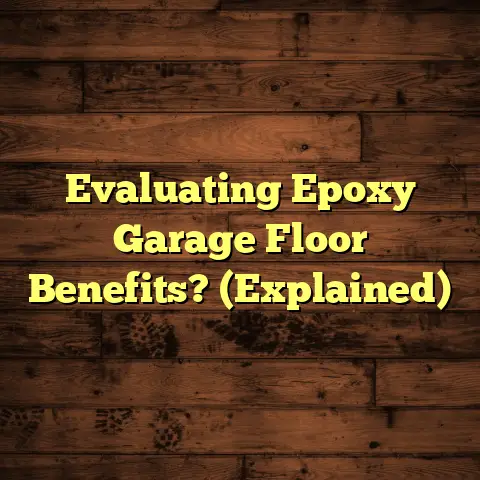Is Poured Concrete Flooring Expensive? (Explained)
Is taste something that is easy to define? Everyone has their own unique preferences, especially when it comes to home design. For some, the sleek look of poured concrete flooring speaks volumes about modernity and sophistication. But then there are those who find it cold and uninviting. So, let’s take a closer look at poured concrete flooring and address a question I often hear: Is poured concrete flooring expensive?
The Costs of Poured Concrete Flooring
When I first started working with poured concrete, I was surprised by the variety of factors that influenced the cost. The price can vary significantly depending on several elements:
- Location: In urban areas, prices tend to be higher due to increased labor costs and demand. In a city like New York, I’ve seen installation costs range from $8 to $15 per square foot, while in rural areas, it could be as low as $5 to $10.
- Design Complexity: Simple gray concrete is relatively inexpensive, but decorative options such as staining, stamping, or adding textures can increase costs significantly. For instance, a stamped concrete floor could set you back anywhere from $12 to $20 per square foot.
- Thickness and Reinforcement: Standard thickness for residential poured concrete is about 4 inches. However, if the project requires more strength—like a garage that will hold heavy vehicles—the thickness might increase, which can add to the overall cost.
My Journey with Poured Concrete
I remember one project vividly. A client wanted a sleek, modern look for their basement. We decided on poured concrete, estimating around 600 square feet for the space. After gathering quotes from local contractors, I found that the average was about $10 per square foot for a basic finish. This brought our total to around $6,000.
However, after discussing options for decorative finishes, we decided to add a stained finish to enhance the appearance. This pushed our new estimate to about $12 per square foot. In total, we were looking at approximately $7,200. While the client was initially hesitant about the price increase, I assured them that the aesthetic appeal and durability of poured concrete would be worth the investment.
The Role of FloorTally in Cost Estimation
In my experience as a flooring contractor, having accurate estimates is crucial for both me and my clients. That’s where FloorTally comes into play. With its ability to pull local material and labor rates, I can create realistic budgets right from the start.
For that basement project, I entered the specifications into FloorTally, which provided an accurate breakdown of costs including materials, labor, and even waste factors. This kind of transparency helped build trust with my client. They appreciated knowing exactly where their money was going.
Maintenance and Longevity
One of the main advantages of poured concrete flooring is its durability. Unlike other flooring options that may need replacing every few years, properly installed concrete can last for decades with minimal maintenance.
I’ve had clients who were initially concerned about upkeep. They wondered if concrete would stain or crack over time. While it’s true that it can stain if not sealed properly, regular sealing every few years can help maintain its appearance and integrity.
Challenges Along the Way
Of course, working with concrete isn’t without challenges. On one job, I encountered unexpected weather conditions that delayed pouring. Rain can ruin a freshly poured slab if it comes too soon. We had to wait for a clear day, which added time to the project.
Additionally, I’ve faced issues with uneven subfloors that required extra leveling before pouring. This not only added complexity but also increased costs due to additional materials and labor needed.
Comparing Options
Throughout my career, I’ve worked with various flooring materials—hardwood, tile, laminate—and each has its pros and cons compared to poured concrete.
- Hardwood: Beautiful and warm but often more expensive to install and maintain.
- Tile: Durable but can crack easily and is often cold underfoot.
- Laminate: Affordable and versatile but lacks the longevity of poured concrete.
When considering long-term value, poured concrete shines through. While its initial cost might be comparable or slightly higher than other options, its lifespan and low maintenance make it an attractive choice.
Tips for Installing Poured Concrete
- Hire Experienced Professionals: If you’re not experienced with concrete work, consider hiring professionals who specialize in this area.
- Plan for Proper Drainage: Ensure your space has proper drainage to avoid water pooling on the surface.
- Choose the Right Finish: Whether you opt for a simple polish or an elaborate stained design, choose a finish that aligns with your style and needs.
- Regular Sealing: To maintain its beauty and durability, plan for regular sealing every few years.
- Consider Insulation: If you’re using it in a colder climate, consider radiant heating systems under the concrete for added comfort.
Technical Specifications of Poured Concrete
Poured concrete flooring involves several technical aspects worth discussing. The composition typically includes:
- Cement: The primary binding agent.
- Aggregates: These can be coarse or fine materials such as sand or gravel.
- Water: Essential for mixing.
- Admixtures: Optional additives that enhance properties like workability or curing time.
The mixing ratio is crucial; too much water can weaken the structure while too little can make it unworkable. A common mix ratio is 1 part cement, 2 parts sand, and 3 parts gravel with just enough water to achieve a workable consistency.
The Manufacturing Process
Understanding how poured concrete flooring is made can help clarify its cost. The process typically involves:
- Designing the Mix: Depending on the intended use—residential or commercial—the mix design will vary.
- Mixing: Using a concrete mixer ensures that all components are blended uniformly.
- Pouring: Once mixed, the concrete is poured into forms that define its shape and thickness.
- Finishing: After pouring, finishing techniques such as troweling or stamping are applied to achieve the desired look.
- Curing: This step is critical as it allows the concrete to gain strength over time through moisture retention.
Each of these steps requires careful attention to detail to avoid issues down the line.
Experiences from Various Projects
Over my career, I’ve tackled diverse projects ranging from residential homes to commercial spaces. One memorable project involved converting an old warehouse into an art studio. The owner wanted an industrial feel but also needed something functional for various art installations.
We decided on poured concrete due to its versatility and aesthetic appeal. However, we ran into challenges with old plumbing lines that complicated our plans for a smooth finish. With some creative problem-solving and adjusting our budget slightly to accommodate additional labor costs for rerouting plumbing, we achieved a stunning result that met the client’s vision perfectly.
Another project involved a family home where we chose a polished finish for their main living area. This required meticulous attention during the finishing process. I recall spending hours ensuring every corner was perfectly polished and free of imperfections. The joy on my client’s face when they saw the final result was worth every moment spent refining those details.
Maintenance Tips for Poured Concrete Flooring
Keeping poured concrete looking great doesn’t have to be difficult. Here are some maintenance tips based on my experiences:
- Regular Cleaning: Sweep or vacuum regularly to remove dust and debris that can scratch the surface.
- Use Appropriate Cleaners: Opt for pH-neutral cleaners rather than harsh chemicals that can damage the sealant.
- Seal Annually: A good sealing schedule can prevent stains and keep your floor looking fresh.
- Address Cracks Promptly: If you notice any cracking or chipping, repair those areas immediately to prevent further damage.
- Avoid Heavy Loads: While concrete is durable, avoiding excessively heavy loads in high-traffic areas can prolong its life.
Financial Considerations
When diving into costs, it’s essential to think beyond just installation prices. There are several financial factors to consider:
- Long-Term Savings: Given its durability and low maintenance needs, poured concrete can save money over time compared to other flooring options that may require frequent repairs or replacements.
- Insurance Costs: Homeowners insurance may factor in flooring materials when assessing overall property value; durable materials like concrete can sometimes lower premiums due to their longevity and low risk of damage.
- Resale Value: Homes with high-quality flooring tend to attract buyers more easily. If you’re planning to sell your home in the future, investing in poured concrete might increase your property’s appeal.
- Energy Efficiency: Depending on your local climate, having insulated concrete floors can help regulate indoor temperatures—leading to lower heating and cooling bills over time.
Final Thoughts on Poured Concrete
After years in the flooring industry, I can confidently say that poured concrete flooring is both an investment and a long-term solution for many homeowners. Yes, it can be more expensive upfront compared to other options; however, its durability and low maintenance often make it worth every penny in the long run.
If you’re considering poured concrete for your home or project, weigh all these factors carefully, and don’t hesitate to reach out to professionals who can guide you through the process. What’s most important is finding the right fit for your taste and lifestyle!
Conclusion
Poured concrete flooring offers a unique blend of durability, aesthetic flexibility, and long-term cost savings that many homeowners appreciate. While initial costs may vary depending on several factors like location and design complexity, investing in this type of flooring often pays off over time through reduced maintenance needs and increased property value.
Whether you’re drawn to its modern look or its practical benefits, understanding all aspects—from installation costs to maintenance—will help you make an informed decision about whether it’s right for your space. As you embark on your flooring journey, remember to consider your personal style preferences alongside practical considerations like budget and maintenance requirements.
So next time someone asks if poured concrete flooring is expensive, you’ll have a well-rounded answer! It’s all about weighing initial costs against long-term benefits while keeping your unique taste in mind as you create your dream space.





